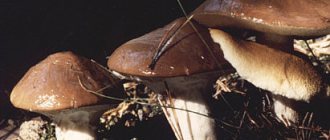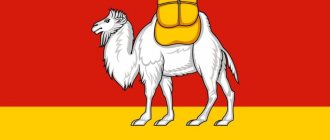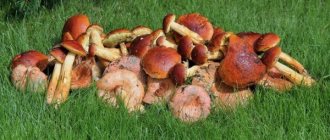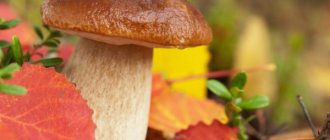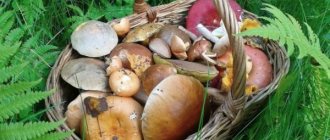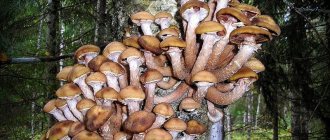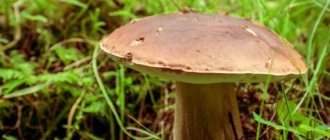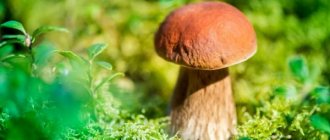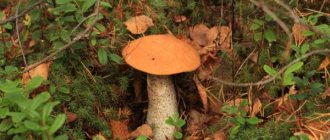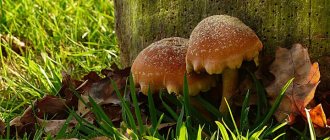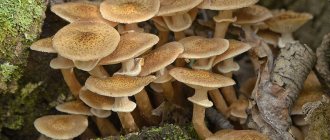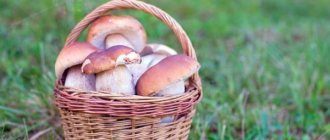Mushrooms of the Ivanovo region
Most of the known species grow here. Forests have dry highlands and wet lowlands. On the hills you can find white mushrooms, boletuses, and milk mushrooms. In swampy areas - boletus and russula. If you look hard enough, you can get saffron milk caps and white milk mushrooms.
Flag of Ivanovo region
Edible
White, boletus. The cap has a pleasant velvety skin, the diameter reaches 30 cm. The color is reddish, light brown. The older the mushroom, the richer its color.
The leg resembles a barrel or a mace. The color is similar to the cap, sometimes it has a pronounced brown tint. The pulp is light, dense, aromatic.
Porcini.
Boletuses. You can identify the redhead by its spherical cap, which tightly hugs the leg. As it ages, its shape changes and becomes convex. It is covered with a dry, velvety skin that hangs from the edges. The hat is difficult to separate. The leg is thickened at the base and has a slightly club-shaped shape.
Red boletus.
Milk mushrooms. Deciduous forests with birches are their main habitat. The shape of the cap is a funnel, the edges are curved inward. The upper part of the mushroom is covered with mucus and has a milky white or slightly yellow tint. When the pulp is broken, a subtle fruity aroma is felt.
The leg is smooth, up to 7 cm long. The color is practically no different from the tone of the cap.
Aspen milk mushroom.
Russula. Hats change shape. They become convex or flat with a concave center. The edges are ribbed or wavy-curved. The surface of the cap is sticky, smooth or dry, velvety to the touch.
The color is varied - from red to bluish tint. The leg is of the correct shape, fixed in the center of the cap. Russulas have fragile flesh, so they must be cut off very carefully.
Russula birch
Hedgehog. This is a strange name for a mushroom and is often confused with chanterelles. Hedgehog mushrooms have funnel-shaped caps with an irregular shape, the edges are curved inward. The main difference from chanterelles is the needles on the inside.
The hat and leg are the same shade (matte cream). The mushroom sits on a thick, elongated stalk that widens at the base. The pulp is fragile.
Yellow hedgehog.
Umbrellas. Some lovers of “silent hunting” consider this species a delicacy. Many people avoid it, confusing it with its poisonous counterparts. It belongs to the champignon family and has a dense fibrous stem. Loves open, light areas - edges, clearings.
Young fruiting bodies have an ovoid cap. Its color is initially white. Then the surface cracks and dark scales appear. The stem is hollow, straight, and easily separated from the cap.
Girl's umbrella.
Chanterelles. The mushroom has a smooth transition from cap to stem. The top is in the form of a funnel with a diameter of up to 12 cm. The color of chanterelles ranges from pale yellow to deep orange.
The leg may be slightly lighter than the upper part, tapering downwards. The pulp is tender, yellow, with a sour taste and smell of dried fruit.
Amethyst Chanterelle
Reshetnik. Refers to the type of boletus. The cap is convex, changes to flat. The surface in wet weather is smooth and oily. The color can be yellow-brown and even red-brown. The name of the mushroom is based on its structure.
The bottom layer resembles a lattice. The leg is short and cylindrical in shape. The pulp is soft, without a pronounced odor. The shade does not change when broken.
Half-legged sieve.
Butter. Widely distributed in coniferous forests where pine, spruce and cedar trees grow. In rare cases, it is placed under an oak or birch tree. If you want to pick up boletus in your basket, it is recommended to look on the edges, forest paths and clearings with good lighting.
The mushroom cap is cushion-shaped, the surface is sticky and shiny. Butterflies often have dirt on top, which hides them from mushroom pickers. The colors of the caps range from yellow to chocolate. Height reaches 15 cm.
Ruby oiler
Raincoat. The mushroom appears quickly after the first rains. Used in cooking and folk medicine.
The fruit body has two shells. The first one has a light tint and cracks. As it grows, it disappears. A darker layer appears. The flesh of puffballs is white in color. The aroma is pleasant, mushroom.
Hedgehog raincoat.
Inedible and poisonous species
The Ivanovo region is famous for its delicious mushrooms. But there are enough false inedible representatives, as well as particularly poisonous species that are distributed throughout the country.
Death cap. Dangerous mushroom. Releases strong toxins that can transfer to edible cut mushrooms if they are in the same container. The hat is up to 14 cm in diameter, convex in shape. Gradually becomes prostrate.
The skin is silky with a green, olive, grayish tint. The leg is thin, long, and has greenish streaks and veins.
White grebe
Pepper mushroom. The flywheel has a cap up to 7 cm in circumference with a brown tone, red, and brown shades. A young mushroom with a round, convex cap. The top layer is dry to the touch, velvety. The height reaches 8 cm, narrowed at the bottom.
The pepper mushroom, unlike its edible counterpart, the butter mushroom, is poisonous. Its toxins have a delayed effect and can accumulate. The taste is sharp and pungent.
Pepper mushroom.
Fly agarics. There are many varieties of fly agarics. The white toadstool has a distinct chlorine odor. And the red representative immediately catches the eye because of its crimson hue with white splashes. In young specimens, a skirt is noticeable, which gradually merges with the leg.
Panther fly agaric.
The pig is thin. The toxicity of the mushroom is caused by the substance muscarine. This is one of the most powerful poisonous alkaloids. Characteristic of fly agarics and toadstools. Even when treated at high temperatures, the pig is not cleaned. The cap is thick and fleshy, funnel-shaped. The edges are curved down.
Color - from olive to brown. There are small fibers on the surface. They don't break off if you touch them. The leg is low, stocky, attached to the edge. The shape of the entire mushroom resembles a pig's ear.
The pig is thin.
Reviews photos
Taking into account the reviews of avid mushroom pickers, we can draw a conclusion. Before you go harvesting, study the growth areas of certain mushrooms. Their characteristics, the soil where they grow. An irreplaceable source of information is local residents.
- Andrey
Mushroom picking is my hobby. I can't wait for this time. I study mushroom places on the map, read reviews on the Internet, participate in forums, but this does not bring the long-awaited result. My advice is to contact local watchmen who have lived in the area for a long time. They will tell you exactly what grows and where. When is the best time to come for mushrooms? And this will be the most reliable information. Given my previous experience, this is exactly what I do.
Mushroom places
- The northern direction is rich in mushrooms.
- Forest area between Chernev and Ovsyannikov.
- Kachalovo (from Kachalovo to Dvorishki).
- South. Yakimannaya, Palkina, Verigino. Forest area between Mikhalev and Gnezdilov.
- Kovrovskoe direction - between Fedotov and Voskresensky.
- Spirdovo, Kharitonovsky quarries. Village Orlovo, Klochkovo, Zeleny Bor.
- Vasilyevskaya side, Litvintsevo, Ivanovo direction, Petrilovskaya.
What is collected by season in the Ivanovo region
| Name. | When they are collected. |
| Morel. | 1st-3rd decade of May. |
| Porcini. | Peak - August, September. |
| Boletus. | June August. |
| Boletus. | End of June - beginning of September. |
| Oil can. | Aug. Sept. |
| Milk mushroom. | Aug. Sept. |
| Raincoat. | August – 1st, 2nd decade of September. |
The Ivanovo region is an excellent place for relaxation and “quiet hunting” at your leisure. During the season, you can pick up a variety of edible mushrooms. But it is better to do this away from heavily polluted roads. A mushroom calendar can help you find these products.
But sometimes it is worth focusing on weather conditions. Abundant growth occurs after rains, when the forest floor has optimal moisture.
From the basket to the restaurant
Alexey Streltsov is from the Kineshma district. He lived in the capital for a long time, had his own business, but in the 90s the company went bankrupt, and a man approaching retirement age was left without a job. Alexey returned to his small homeland, to his parents. I fell into depression. His father, an experienced mushroom picker, began to take his son with him into the forest to save his son from melancholy and gloomy thoughts. So the man, whose brain was already geared towards business, came up with the idea of making money from the forest harvest. “I decided that today, when modern people are accustomed to eating everything from the supermarket, in the era of artificial products such goods should be in special demand,” the man recalls. – I read that in Europe there are special companies involved in the collection, sorting, preparation and processing of berries. Why are we worse than Europeans?”
First, he walked around the village with an offer to earn extra money. Several people responded. Organized the supply of mushrooms to two metropolitan restaurants. At the same time, at home, the man’s mother and sister made preparations from forest gifts, which also sold well in Moscow.
Today the man opened his own restaurant, which specializes in homemade food and dishes using forest products. He does not hide that his past experience helped him in many ways; he had to work a lot. But in the “lean” years there was a desire to give up everything and do something else. “For me, the words ‘for mushrooms and for berries’ became almost a motto: it was the forest that gave me the opportunity to organize a business and confidence in the future,” the man smiles. “I’m inclined to think that you can always earn a piece of bread this way: the main thing is not to be lazy and not to be afraid of anything.”
| TO THE POINT |
| As the press service of the Ivanovo administration reported, selling mushrooms and berries on the streets of the city, near shops, and on road routes is prohibited. However, forest products can be bought at markets. Experts advise asking street vendors for a certificate stating that their goods have passed special control. All fairs and markets in the city have equipped veterinary laboratories where samples are taken. If there is no such certificate, it is better to refuse the purchase. |
